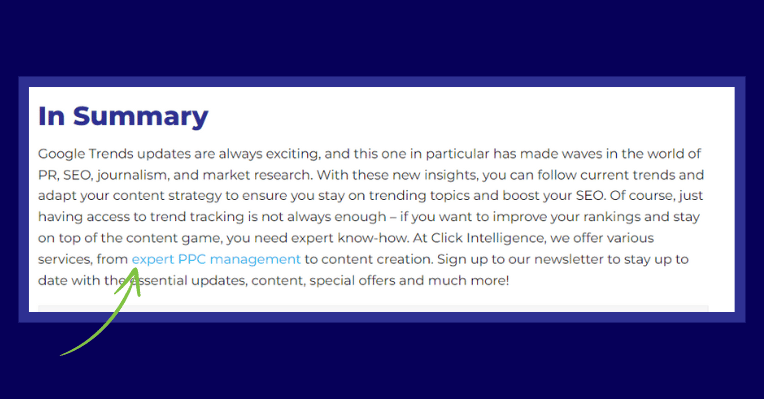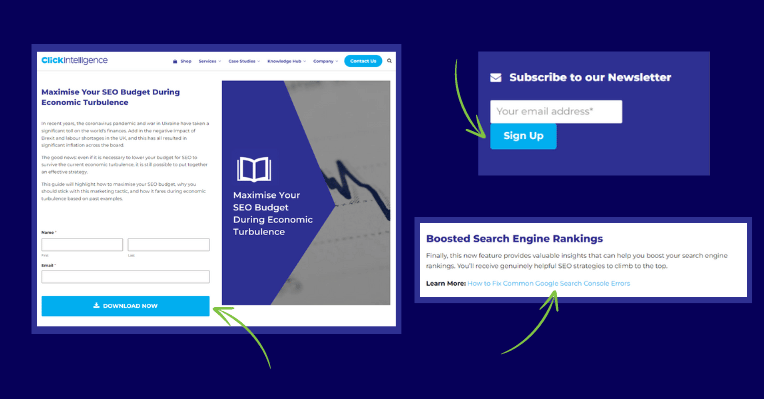2026 SEO Agency Toolkit: Services, Trends & Growth Hacks
If you want your agency to be ahead in 2026, you need to stay sharp,…
You’ve invested in SEO. Your traffic is looking good, your rankings are solid, and you’ve ticked all those boxes on-site and on-site and…
Nothing.
You have the traffic but no sales. You have the eyes, but no takers.
That’s what can happen when you keep SEO in a silo. SEO isn’t a goal on its own. It isn’t the be-all-and-end-all of marketing. It is, instead, SEO management is a way to prop up all of your other efforts so that they work better, and last longer.
If your traffic isn’t turning into sign-ups, sales, or subscriptions, then the problem isn’t the SEO – it’s that you haven’t added SEO conversion rateA conversion rate is the percentage of visitors that take a desired action on your site. optimisation to the mix.
SEO and CRO are not two separate strategies that you can or should pick over the other. They are complimentary. Just as you’ll want to add short-term marketing efforts like PPC, social media marketing, and other retargeting efforts to your SEO strategy, you’ll also want to add CRO.
To refresh, here’s what you need to know about SEO and CRO services:
SEO (search engine optimisation) refers to the strategies you use on your website and off of it to help search engines (and this now includes generative AI algorithms) understand your brand, and help link your content to those using search engines. It starts with an SEO audit, and then moves into link-building and content.
The goal of SEO is to increase visibility on relevant searches, and to draw in organic search.
The benefit of investing in SEO services is that your entire presence is optimised for humans and for algorithms.
In short, SEO works to increase your overall visibility in the long run and improves the user experience from day one.
SEO conversionA conversion is a desirable result on a website that leads to an action such as completing an order, filling out a form, or simply clicking on a link. rate optimisation refers to the efforts you make towards reducing your bounce rateBounce rate is the percentage of visitors to a website who visit only one page. A high bounce rate indicates that visitors are not satisfied with your website. and converting a visitor into a longer-term relationship.
CRO rates, in general, are relatively very low. On average, B2B eCommerce brands see average SEO conversion rates of just 2.1% overall during the year, and only 1.5% from organic search. This means between 1% to 3% of site visits, on average, result in a sale or sign-up.
This doesn’t mean conversion rate SEO is pointless. Investing in personalisation, optimising landing pages with technical SEO audits, and fine-tuning your marketing funnels can help boost conversion in SEO massively. Personalized CTAs and CRO keywords alone have a 202% higher conversion rate than generic ones, for example.
An SEO consultancy works to connect you to potential users through organic search, while also improving the standards of your site so that those users like what they see. SEO conversion takes your content to the next level by implementing additional strategies to get those visitors to commit, in some way, to your brand.
On page SEO essentially is the groundwork that CRO onpage optimization follows through on. Step on, and step two. They do not conflict in any way, and instead work to prop each other up.
SEO is still incredibly relevant. In 2022, organic clicks accounted for 45.1% of all search result clicks, not paid ones. People are indeed still using search engines to find information, but the benefits of SEO don’t stop at search engine visibility. Instead, today, SEO is all about building credibility.
While building credibility is essential for establishing a strong digital presence and brand reputation, it doesn’t increase sales or sign-ups. That’s why you’ll need to use these tips to integrate your SEO and CRO together to bring in more traffic and conversions, regardless whether you’re doing this in-house or are looking to add CRO and SEO to your agency through our white label SEO services:
Call to Actions are the bread and butter of SEO conversions, and they need to begin with your meta data. This means you need to optimise your page title and description to draw in users and convince them that you’re worth the click. You can work to stand out even on the first page by optimising your meta data with strong CRO keywords. This can be a very powerful way to use CRO for local search, since you can highlight the specific neighbourhood you’re located in.
Writing well-written and fully optimised content is great. If that content is in a silo, however, it isn’t going to be useful for your CRO onpage optimization efforts.
To produce content that does indeed convert, you need to understand why someone would be interested in the topic, and craft multiple CRO keywords along the way that focus on that user intent. This is particularly important if you are expanding internationally, and are using a wider international SEO approach to break into new markets.
In some cases, adding conversion SEO to your site can be as simple as ensuring you have a very strong search system for your products, so customers can narrow down what they want to the dot. In other cases, it could mean offering a full report for download – so long as they provide their email.
Your content needs to be designed to suit customers at every stage of the journey, and to have personalised CRO keywords that suit that stage. Sometimes, all it takes is for a CRO blog to lead into a product round-up to convert someone from the information-gathering stage, to a paying customer.

Creating CRO content for every stage of the customer journey is a smart SEO content marketing strategy that can easily work into your overall strategy, so long as you work to connect the pieces of content in your CRO blog. Do this by using personalized CTAs, and focus on soft sale conversions at the earlier stages of the customer journey, and then harder sales later on. If you have a large-scale business, however, it can be daunting, so don’t be afraid to invest in enterprise SEO for the optimisation process.
Not every customer is going to want to immediately pitch the hard sale. In fact, most don’t. On average, it takes seven interactions between a potential customer and a brand before that person is ready to buy. That’s why it’s so important to offer soft sale options, and draw-ins like a CRO blog.
Call to actions, after all, doesn’t always immediately have to be about buying. It could, instead, be about taking someone looking into a topic from one guide into another. It could be about getting them to sign up for a newsletter so they can learn more, straight in their inbox.

CRO onpage optimization doesn’t just take place on your website. Create valuable and in-depth guest posts, use PR marketing to get interviewed, and more. This is great for increasing your visibility and reach online. Still, more importantly it works to help convince customers of your reputation and authority, which in turn can help you funnel those audiences to your website. Once again, with built-in call to actions.
Google's Core Web Vitals reports how a page performs, and here's our checklist to improving page experience this 2022!
Budgeting for SEO is a terrifying prospect. There are so many elements in play, and seemingly endless considerations, rendering it…
Ah, 2021 – the year of volatile Google algorithm updates that shook marketers from within and left website owners scratching…